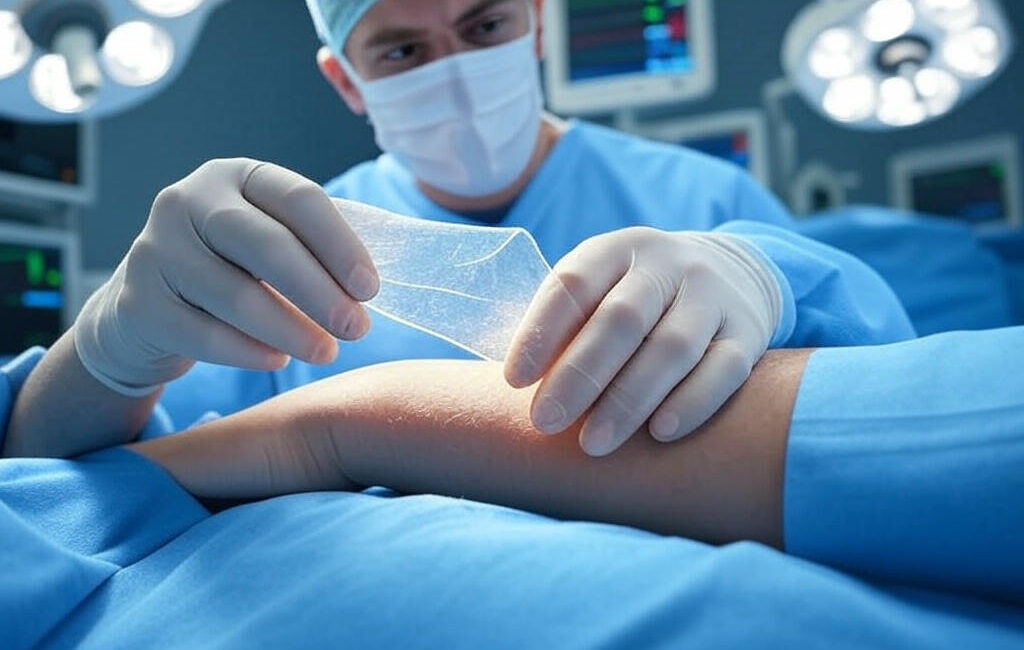A skin graft is a long-standing and invasive surgical procedure. It requires removing healthy skin from another location on your body and transplanting it to an area where skin has been lost or damaged.
Plastic Surgeons routinely use skin grafts for the treatment of burns, wounds, and surgical defects with impaired healing. The technique allows for faster healing, reduced chance of infection, and better cosmetic appearance of the skin.
Finally, the article discusses the different types of skin grafts, their uses, and some care instructions.
What Exactly is Skin Grafting?
Skin grafting is a common surgical procedure to repair damaged skin, particularly useful in reconstructive surgery. It involves transferring a thin sheet of healthy skin from a donor site to a wound or scar, often following skin cancer treatments or burn injuries. Doctors may utilize a full thickness skin graft or a partial-thickness graft depending on the depth of the wound, ensuring that the graft succeeds by promoting the healing process effectively.
Healthy skin at the donor site is crucial for the graft take, as it allows the new patch to bond and heal properly. While autologous grafts from the patient’s own body are typically preferred, cadaveric grafts may also be utilized when necessary. Grafting not only promotes faster wound healing but also restores the appearance and function of the skin.
Proper care of the donor sites is essential, as they can heal and be reused after a period of time. This method significantly reduces the chances of infection and aids in the regeneration of skin, making it a vital option for treating chronic wounds and skin loss.
Exploring Different Graft Types
In this article, we explore the different types of skin grafts and their importance to burn and wound recovery. There are dozens, each with their own respective strengths. In practice, surgeons frequently make a dichotomous decision between full-thickness and split-thickness skin grafts.
Full-thickness grafts take even more skin, which includes both the epidermis and dermis layers. They are particularly good for delicate, visible areas such as the face and heal with minimal shrinkage. Split-thickness grafts, consisting of a very thin layer of skin, are able to cover much larger areas and allow burned areas to heal more quickly.
|
Graft Type |
Structure |
Best Uses |
|---|---|---|
|
FTSG |
Both epidermis and dermis |
Face, hands, small wounds |
|
STSG |
Epidermis, part of dermis |
Large burns, big wounds |
Alternatives are autografts (tissue from the patient), allografts (tissue from another human), and xenografts (animal tissue). Composite grafts combine skin and cartilage, often used for the nose or ear.
Epidermal skin grafts are very thin, heal quickly, and require less post-operative care compared to other grafts. When a wound is particularly deep, or a joint must remain mobile, doctors can utilize skin flaps—living tissue that is transplanted with its own blood supply.
Research has shown that autografts generally provide better closure and healing, but both allografts and bioengineered grafts are beneficial when large tissues are lost. At Phoenix Plastic Surgery Centre in Bangalore, surgeons utilize these options to tailor treatment to each patient’s individual needs.
Your Skin Graft Procedure Journey
A skin graft is a procedure that can be scheduled weeks in advance, so all patients have the opportunity to prepare. Pre-operative preparation begins with medical evaluations, blood tests, and an outline of the procedure area.
The surgical team will instruct patients to refrain from eating and drinking after midnight to ensure a safe procedure. During the procedure, anesthesia—local or general—ensures that the patient remains pain-free.
The surgeon will go through the wound, choose a donor site, and move a skin patch while being. The donor site, which is usually kept covered for 3 to 5 days, can sting and ooze for some time.
Recovery takes weeks, occasionally longer, and the graft site can appear red or purple initially. At Phoenix Plastic Surgery Centre, Bangalore we offer regular post-operative care.
Our team walks alongside patients as they heal, and provides assistance during their hospital stay when necessary.
Healing: What to Really Expect
Healing following a skin graft proceeds along well-defined lines of demarcation, or stages. Swelling and redness in the beginning are expected as a new blood supply begins to pool in at the new location.
For the average person, the graft requires two to four weeks to bond and start healing. It can take months to fully regain sensation. The appearance of the graft can be white, scarred, or discolored before it matures and integrates better.
Dressing changes are often daily in the first week and sometimes two to three times through the following weeks. To achieve optimal outcomes, the multi-disciplinary team at Phoenix Plastic Surgery Centre, Bangalore vigilantly supervises post-operative follow-ups.
They further stress the importance of protecting clients’ new skin from sun exposure, stress, and infection.
Weighing Benefits and Potential Risks
Skin graft surgery offers significant benefits for individuals requiring reconstructive solutions. With successful skin grafts healing in as little as two to three weeks, patients often experience quicker closure of wounds, enabling better functionality of their hands or feet. The aesthetic outcome frequently appears and feels more natural compared to alternative treatments.
However, despite taking necessary precautions, risks such as loss of the graft, infection, and scarring remain. The skin at the graft site may tighten or produce unusual sensations, with some patients reporting loss of sensation while others face heightened sensitivity.
Smoking complicates the healing process and can hinder recovery, so medical professionals strongly advise quitting. At Phoenix Plastic Surgery Centre in Bangalore, advanced techniques are employed to monitor patients post-operatively, which is crucial to prevent complications like graft failure that could lead to extended hospital stays or additional procedures.
Skin Grafts for Burns vs. Reconstruction
Whether the skin grafts are closing wounds or rebuilding body parts, the intent can shift depending on the cause. To treat burn injuries, surgeons often need to use STSG to cover extensive areas and encourage rapid wound healing.
These grafts require a donor site to heal in approximately two weeks. In reconstruction, like the case of repairing a disfigured face or hand, surgeons often use full-thickness grafts (FTSG) to get the best color and texture.
These grafts take longer to heal, five to seven days, but produce a greater amount of hair. Especially for a visible spot, matching skin tone is important, but surgeons consider the risk of scarring.
At our institution, Phoenix Plastic Surgery Centre, Bangalore, we employ autografts, allografts, and bioengineered grafts for burn and reconstructive cases. Each graft is customized to the individual’s needs to minimize scarring.
Modern Advances in Skin Grafting
Today’s advances in skin grafting incorporate innovative techniques and advanced technology to facilitate faster, more efficient healing for patients. Doctors and researchers have made great strides in the field of 3D-printed skin. They can now grow skin to match a hand exactly, with lab-grown substitutes such as Matriderm, Integra and AlloDerm.
These substitutes are especially useful when there isn’t enough healthy skin available to transplant. One group has gone as far as to test fish skin as a wound cover, yielding impressive results. New work with stem cells and CRISPR lets experts build skin with blood vessels and other parts, sometimes using mice before humans.
Today at Phoenix Plastic Surgery Centre in Bangalore, surgeons like Dr. Raghavendra Kaladagi, utilize these new tools deliver safer, more reproducible and effective results. Although the need for further studies and trials is paramount, the changes made provide optimism in the field for years to come.
Conclusion
Skin grafts have become an integral aspect of wound care and repair. Citizens encounter them following burns, deep lacerations, and those difficult wounds that simply refuse to heal. Doctors rely on them to regrow skin, prevent infections, and restore patients’ mobility and quality of life more quickly. Fresh approaches, such as advanced technologies and artificial skin, are offering greater promise and improved appearances. People in Bengaluru now get experienced hands and ethical advice at Phoenix Plastic Surgery Centre.
Dr. Raghavendra Kaladagi and his team have it down to a science, from the initial discussion to the final follow-up. Those of you who have questions or concerns about skin grafts can rely on accurate information and consistent treatment right here. Visit Phoenix Plastic Surgery Centre in Bangalore for a consultation and make an appointment today!
Emergency Cases
Frequently Asked Questions
What is a skin graft and when is it needed?
How long does it take to recover from a skin graft?
Are there different types of skin grafts available?
Can skin grafts help with burn injuries?
What risks should I know about before getting a skin graft?
What modern advances in skin grafting are available in Bangalore?
How can I prepare for a skin graft procedure?

